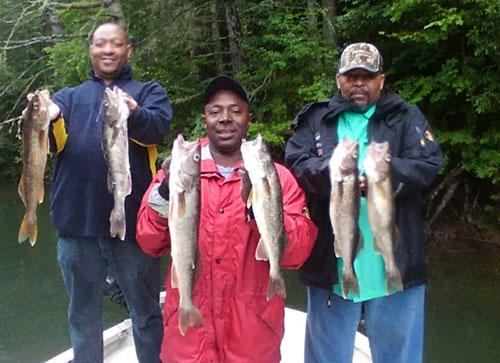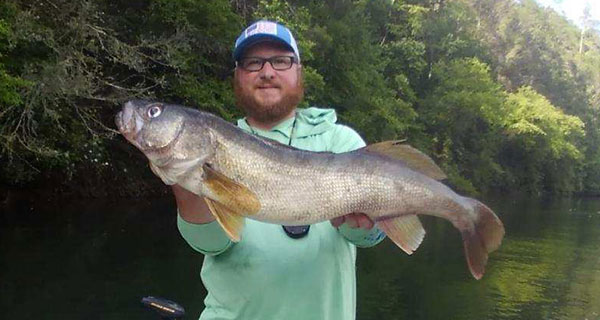Summer is most definitely here, and the fishing has been as hot as the weather. We are catching a ton of stripers, hybrids, smallmouth, spots, largemouth, crappie, and even catfish, but the species I want to focus on this month is walleye. Every time I post Facebook pictures of walleye my phone rings off the hook with inquiries regarding walleye trips, and we have caught a lot of them over the last couple of months. With that in mind, I would like to talk about the walleye fishery, both past and present, in this wonderful lake.
Historically speaking, Hiwassee used to be an extremely productive walleye fishery, rivaling Fontana or any other lake in the South in terms of sheer numbers of catchable walleye. However, the introduction of blueback herring into the fishery led to a serious decline in walleye numbers. Natural spawning recruitment plummeted, and I honestly wondered for a while if there was a future for these fish in the lake. Luckily, the state stepped in and started a stocking program that has been somewhat successful, and there is still a bit of natural spawning occurring, as well.
In terms of walleye today in Hiwassee, numbers are simply not what they used to be. Gone are the days of catching limit after limit when they ran the river in late winter/early spring, when they ran back down lake after spawning, at night under a Coleman lantern all summer long, and again in winter jigging a spoon or ice jig. However, at certain times and under certain conditions, there are still catchable fish in the lake.

I mentioned at the beginning of this article that I get a ton of calls about walleye trips, and I tell everyone that calls me the same thing. I feel like I catch as many or more walleye than just about anybody on the lake, but I also feel that it is disingenuous and a bit unethical to advertise and book walleye only trips. Simply stated, the population is not such that I (or anyone else for that matter), as a guide, can say with certainty that we can go out and catch a cooler full of walleye. Instead, I book trips for other species, but if I have run into walleye or feel that conditions are right for them I am more than happy to give the client that option.
In terms of the best time to run into a Hiwassee walleye, I have caught them twelve months a year, but I prefer the timeframe between December and late August, depending on the weather and water levels, with fall being my least favorite time for them personally. If you are interested in a striper, smallmouth, crappie, or just a “whatever is biting” best trip on Hiwassee and want the possibility of hooking into a walleye or 6, please give me a call at 865-466-1345, and I will be happy to talk to you a bit more in depth.
Aaron Kephart is the Owner of Mountain Lakes Guide Service. To book a guided trip on one of the Murphy area mountain lakes, contact him by phone or by email at mtnlakesguide@outlook.com Check out his website at http://www.mtnlakesguideservice.com and catch him on facebook@mountainlakesguideservice.
